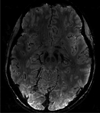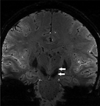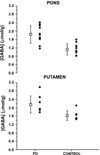Magnetic Resonance Imaging (MRI) in Parkinson's Disease
- PMID: 24639916
- PMCID: PMC3955053
- DOI: 10.4172/2161-0460.S1-001
Magnetic Resonance Imaging (MRI) in Parkinson's Disease
Abstract
Recent developments in brain imaging methods are on the verge of changing the evaluation of people with Parkinson's disease (PD). This includes an assortment of techniques ranging from diffusion tensor imaging (DTI) to iron-sensitive methods such as T2*, as well as adiabatic methods R1ρ and R2ρ, resting-state functional MRI, and magnetic resonance spectroscopy (MRS). Using a multi-modality approach that ascertains different aspects of the pathophysiology or pathology of PD, it may be possible to better characterize disease phenotypes as well as provide a surrogate of disease and a potential means to track disease progression.
Keywords: Adiabatic methods R1ρ and R2ρ; Diffusion Tensor Imaging (DTI); Magnetic Resonance Spectroscopy (MRS); Magnetization transfer imaging (MTI); Relaxations along a Fictitious Field (RAFF); Resting-state MRI; Susceptibility-weighted imaging (SWI); T2*; Voxel-based morphometry (VBM).
Figures




References
-
- Rutledge JN, Hilal SK, Silver AJ, Defendini R, Fahn S. Study of movement disorders and brain iron by MR. AJR Am J Roentgenol. 1987;149:365–379. - PubMed
-
- Gorell JM, Ordidge RJ, Brown GG, Deniau JC, Buderer NM, et al. Increased iron-related MRI contrast in the substantia nigra in Parkinson’s disease. Neurology. 1995;45:1138–1143. - PubMed
-
- Cho ZH, Oh SH, Kim JM, Park SY, Kwon DH, et al. Direct visualization of Parkinson’s disease by in vivo human brain imaging using 7.0T magnetic resonance imaging. Mov Disord. 2011;26:713–718. - PubMed
-
- Zecca L, Youdim MB, Riederer P, Connor JR, Crichton RR. Iron, brain ageing and neurodegenerative disorders. Nat Rev Neurosci. 2004;5:863–873. - PubMed
Grants and funding
LinkOut - more resources
Full Text Sources
Other Literature Sources
